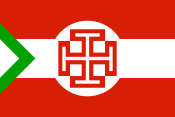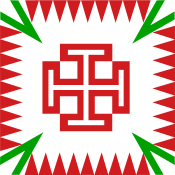
Back Айчынны фронт (Аўстрыя) Byelorussian Отечествен фронт (Австрия) Bulgarian Vlastenecká fronta (Rakousko) Czech Vaterländische Front German Πατριωτικό Μέτωπο (Αυστρία) Greek Vaterländische Front Esperanto Frente Patriótico (Austria) Spanish حزب وطنپرستان Persian Front patriotique (Autriche) French מפלגת חזית המולדת האוסטרית HE
Fatherland Front Vaterländische Front | |
|---|---|
 | |
| Federal leader | Engelbert Dollfuß (20 May 1933 – 25 July 1934) Ernst Starhemberg (31 July 1934 – 15 May 1936)[1] |
| Founded | 20 May 1933 |
| Dissolved | 13 March 1938 |
| Merger of | CS, Landbund, Heimwehr |
| Youth wing | Österreichisches Jungvolk[2] |
| Paramilitary wing | Ostmärkische Sturmscharen (Until 1936) Assault Corps[3] |
| Membership | 3,000,000 (1937 est.)[4] |
| Ideology | Austrian nationalism[5] Corporate statism[6][7] Authoritarian conservatism[8] Clerical fascism[9][10][11] |
| Political position | Right-wing[12] to far-right[13] |
| Religion | Roman Catholicism |
| Colours | Red Green White |
| Slogan | "Österreich, erwache!" (lit. 'Austria, awaken!')[14] |
| Anthem | "Song of the Youth"[15] |
| Party flag | |
 | |
The Fatherland Front (Austrian German: Vaterländische Front, VF) was the right-wing conservative, authoritarian, nationalist, and corporatist ruling political organisation of the Federal State of Austria. It claimed to be a nonpartisan movement, and aimed to unite all the people of Austria, overcoming political and social divisions.[16] Established on 20 May 1933 by Christian Social Chancellor Engelbert Dollfuss as the only legally permitted party in the country, it was organised along the lines of Italian Fascism, was fully aligned with the Catholic Church, and did not advocate any racial ideology, as Italian Fascism later did. It advocated Austrian nationalism and independence from Germany on the basis of protecting Austria's Catholic religious identity from what they considered a Protestant-dominated German state.[17]
The Fatherland Front, which was strongly linked with Austria's Catholic clergy, absorbed Dollfuss's Christian Social Party, the agrarian Landbund and the right-wing paramilitary Heimwehren, all of which were opposed to Nazism, Marxism, laissez-faire capitalism and liberal democracy. It established an authoritarian and corporatist regime, the Federal State of Austria, which is commonly known in German as the Ständestaat ("corporate state"). According to the Fatherland Front this form of government and society implemented the social teaching of Pope Pius XI's 1931 encyclical Quadragesimo anno.[10][18] The Front banned and persecuted all its political opponents, including Communists, Social Democrats—who fought against it in a brief civil war in February 1934—but also the Austrian Nazis who wanted Austria to join Germany.[19] Chancellor Dollfuss was assassinated by the Nazis in July 1934. He was succeeded as leader of the VF and Chancellor of Austria by Kurt Schuschnigg, who ruled until the invigorated Nazis forced him to resign on 11 March 1938. Austria was annexed by Nazi Germany the next day.
The Fatherland Front maintained a cultural and recreational organisation, called "New Life" (Neues Leben), similar to Germany's Strength Through Joy.[20] The "League of Jewish Front Soldiers" (Bund Juedischer Frontsoldaten), the largest of several Jewish defense paramilitaries active in Austria at the time, was incorporated into the Fatherland Front.[21]
The role of the Fatherland Front has been a contentious point in post-war Austrian historiography. While many historians consider it to be the exponent of an Austrian and Catholic-clerical variant of fascism—dubbed "Austrofascism"—and make it responsible for the failure of liberal democracy in Austria, conservative authors stress its credits in defending the country's independence and opposition to Nazism.[22]
- ^ Der Vizekanzler – Führer der Vaterländischen Front. In Neue Freie Presse, 31 July 1934 (german).
- ^ Johanna Gehmacher: youth without a future. Hitler Youth and the Federation of German Girls in Austria before 1938, Picus, Vienna 1994, ISBN 3-85452-253-3, pp. 401–420 (dissertation Uni Wien 1993, under the title: National Socialist Youth Organizations in Austria, 479 pages).
- ^
- Robert Kriechbaumer (2002), Ein vaterländisches Bilderbuch: Propaganda, Selbstinszenierung und Ästhetik der Vaterländischen Front 1933–1938, Schriftenreihe des Forschungsinstitutes für politisch-historische Studien der Dr.-Wilfried-Haslauer-Bibliothek 17 Robert Kriechbaumer, Hubert Weinberger, Franz Schausberger (in German), Wien: Böhlau, p. 48, ISBN 978-3-205-77011-4
- Emmerich Tálos (2013), Das austrofaschistische Herrschaftssystem: Österreich 1933–1938, Politik und Zeitgeschichte 8 (in German) (2 ed.), Münster: LIT Verlag, p. 226, doi:10.1093/ehr/cew289, ISBN 978-3-643-50494-4
- Arnd Bauerkämper, Grzegorz Rossoliński-Liebe, ed. (2017), Fascism without Borders: Transnational Connections and Cooperation between Movements and Regimes in Europe from 1918 to 1945 (in German), New York: Berghahn Books, p. 174, doi:10.2307/j.ctvw04hnr, ISBN 978-1-78533-469-6, JSTOR j.ctvw04hnr
- ^ Payne, Stanley G. (1995). A History of Fascism, 1914–1945. University of Wisconsin Press. p. 249. ISBN 9780299148706.
- ^ Spohn, Willfried (2005), "Austria: From Habsburg Empire to a Small Nation in Europe", Entangled identities: nations and Europe, Ashgate, p. 61.
- ^
Badie, Bertrand; Berg-Schlosser, Dirk; Morlino, Leonardo, eds. (2011). International Encyclopedia of Political Science. Sage Publications. ISBN 9781483305394. Retrieved 9 September 2020.
[...] fascist Italy [...] developed a state structure known as the corporate state with the ruling party acting as a mediator between 'corporations' making up the body of the nation. Similar designs were quite popular elsewhere in the 1930s. The most prominent examples were Estado Novo in Portugal (1932–1968) and Brazil (1937–1945), the Austrian Standestaat (1933–1938), and authoritarian experiments in Estonia, Romania, and some other countries of East and East-Central Europe.
- ^ Pelinka, Anton (2017). The Dollfuss/Schuschnigg Era in Austria: A Reassessment. Routledge. p. 249.
- ^ Günter J. Bischof, Anton Pelinka, Alexander Lassner. The Dollfuss/Schuschnigg Era in Austria: A Reassessment. Piscataway, NJ: Transaction Publishers, 2001. p. 26.
- ^ Binder, Dieter A. (2009). The Christian Corporatist State: Austria from 1934 to 1938. Austria in the Twentieth Century. Transaction Publishers. p. 75.
- ^ a b Pyrah (2008). Enacting Encyclicals? Cultural Politics and 'Clerical Fascism' in Austria. p. 162.
- ^ H.R. Trevor-Roper, "The Phenomenon of Fascism", in S. Woolf (ed.), Fascism in Europe (London: Methuen, 1981), especially p. 26. Cited in Roger Eatwell, "Reflections on Fascism and Religion" Archived 2007-05-01 at the Wayback Machine
- ^ "1934 to 1938: Ständestaat in the Name of 'God, the Almighty'". City of Vienna. Retrieved November 3, 2019.
His politics were supported by the Fatherland Front, a reservoir for nationalist, Christian and generally right-wing conservative forces.
- ^ Bopp, Christoph (2018-02-11). "Nationalsozialismus – «Österreich muss Österreich bleiben!» sprach Schuschnigg – doch das reichte nicht". Solothurner Zeitung (in German). Retrieved 2024-10-06.
- ^ Jelavich, Barbara (1987). Modern Austria: Empire and Republic, 1815–1986. Cambridge University Press. p. 200.
- ^ Erlebte Geschichte (Autobiografie, geschrieben 2000), Seite 173 (online).
- ^ Thuswaldner, Gregor (2006). "Dollfuss, Engelbert (1892–1934)". In Domenico, Roy Palmer; Hanley, Mark Y. (eds.). Encyclopedia of Modern Christian Politics. Greenwood Press. p. 174.
- ^ Atsuko Ichijō, Willfried Spohn. Entangled identities: nations and Europe. Ashgate Publishing, Ltd., 2005, p. 61.
- ^ Binder, Dieter A. (2009). The Christian Corporatist State: Austria from 1934 to 1938. Austria in the Twentieth Century. Transaction Publishers. p. 75.
- ^ Binder (2009). The Christian Corporatist State. p. 73.
- ^ Pyrah (2008). Enacting Encyclicals? Cultural Politics and 'Clerical Fascism' in Austria. p. 160.
- ^ Unknown, Unknown. "Modern Era >> Anti-Semitism". Jewish Communities of Austria. National Fund of the Republic of Austria for Victims of National Socialism. Archived from the original on 26 January 2021. Retrieved 20 November 2009.
- ^ Tálos, Emmerich; Neugebauer, Wolfgang (2014). "Vorwort". Austrofaschismus: Politik, Ökonomie, Kultur, 1933–1938 (7th ed.). Lit Verlag. pp. 1–2.

